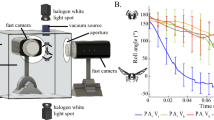Summary
The contribution of head movement to the control of roll responses in flying locusts (Locusta migratoria) has been examined (i) on a flight balance, recording the angles through which the locust turns when following an artificial horizon; (ii) by recording activity in a pair of flight muscles in restrained conditions; and (iii) by observations on free flying locusts. Responses were compared when the head was free to turn about the thorax, as normal, and when the head was waxed to the thorax, blocking any relative motion between the two (‘head-fixed’). These experiments suggest that the major signal generating corrective roll manoeuvres is the visual error between the angle of the head and the horizon, rather than a signal that includes a measure of the head-thorax angle.
-
1.
On the flight balance in the head-free condition the roll angle of the thorax was consistently less than in the head-fixed state, and followed the stimulus with longer response lags. Furthermore, the difference between the angle of the thorax assumed during head-free and head-fixed rolls was close to the angle of the head relative to the thorax during head-free responses.
-
2.
Records of activity of the forewing first basalar muscles (M97) were made during rotation of the horizon about immobilized animals. When the head could follow the horizon, the relative latency between activity in the left and right basalar muscles decreased as the head position turned to approach the displaced horizon. When head-fixed, the relative latency was directly proportional to horizon angle.
-
3.
The relative latency between left and right M97 flight muscles correlates better with the visual error signal than with the horizon position signal, lagging by approximately 40 ms.
-
4.
In the open air, head-fixed locusts appear able to fly as well as head-free locusts.
These data suggest that the reduction in visual inputs caused by compensatory motion of the head during roll manoeuvres is not functionally replaced by inputs from cervical proprioceptors. Some reasons why the locust may nevertheless allow head movement relative to the thorax during flight are discussed.
Similar content being viewed by others
References
Arbas EA (1986) Control of hindlimb posture by wind-sensitive hairs and antennae during locust flight. J Comp Physiol A 159:849–858
Baker PS (1979) The wing movements of flying locusts during steering behaviour. J Comp Physiol 131:49–58
Baker PS, Cooler RJ (1979a) The natural flight of the migratory locust, Locusta migratoria L. I: Wing movements. J Comp Physiol 131:79–88
Baker PS, Cooler RJ (1979b) The natural flight of the migratory locust, Locusta migratoria L. I: Gliding. J Comp Physiol 131:89–94
Collett TS (1980) Angular tracking and the optomotor response: An analysis of visual reflex interaction in the hoverfly. J Comp Physiol 140:145–158
Doebelin EO (1985) Control system principles and design. J. Wiley & Sons, New York
Gewecke M (1972) Antennen und Stirn-Scheitelhaare von Locusta migratoria L. als Luftströmungsorgan bei der Flugsteuerung. J Comp Physiol 80:57–94
Gewecke M (1975) The influence of the air-current organs on the flight behaviour of Locusta migratoria. J Comp Physiol 103:79–96
Goodman LJ (1965) The role of certain optomotor reactions in regulating stability in the rolling plane during flight in the desert locust, Schistocerca gregaria. J Exp Biol 42:382–407
Haskell PT (1959) Function of certain prothoracic hair receptors on the desert locust. Nature 183:1107
Hensler K (1988) The pars intercerebralis neurone PI(2)5 of locusts: convergent processing of inputs reporting head movements and deviations from straight flight. J Exp Biol 140:511–533
Land MF (1975) Head movements and fly vision. In: GA Horridge (ed) The compound eye and vision of insects. Clarendon Press, Oxford, pp 469–489
Miall RC, Hereward CH (1988) A simple miniature capacitative position transducer. J Exp Biol 138:541–544
Mittelstaedt H (1950) Physiologie des Gleichgewichtssinnes bei fliegenden Libellen. Z Vergl Physiol 32:422–463
Möhl B, Bacon J (1983) The TCG wind-sensitive interneurones in the locust. II. Directional sensitivity and role in flight stabilisation. J Comp Physiol 150:453–465
Pflüger H-J, Tautz J (1982) Air movement sensitive hairs and interneurons in Locusta migratoria. J Comp Physiol 145:369–380
Roffey J (1963) Observations on gliding in the desert locust. Anim Behav 11:359–366
Rowell CHF (1988) Mechanisms of flight steering in locusts. Experientia 44:389–395
Sandeman DC (1968) A sensitive position measuring device for biological systems. Comp Biochem Physiol 24:635–638
Schmidt J, Zarnack W (1987) The motor pattern of locusts during visually induced rolling in long-term flight. Biol Cybern 56:397–410
Simmons PJ (1980) A locust wind and ocellar brain neurone. J Exp Biol 85:281–294
Snodgrass RE (1929) The thoracic mechanism of a grasshopper and its antecedents. Smithson Misc Coll 82:1–112
Taylor CP (1981a) Contribution of compound eyes and ocelli to steering of locusts in flight. I. Behavioural analysis. J Exp Biol 93:1–18
Taylor CP (1981b) Contribution of compound eyes and ocelli to steering of locusts in flight. II. Timing changes in flight motor units. J Exp Biol 93:19–32
Thorson J (1966) Small signal analysis of a visual reflex in the locust. I. Input parameters. Kybernetik 3:41–52
Thüring DA (1986) Variability of motor output during flight steering in locusts. J Comp Physiol A 158:653–664
Tomioka K, Yamaguchi T (1980) Steering responses of adult and nymphal crickets to light, with special reference to the head rolling movement. J Insect Physiol 26:47–57
Weis-Fogh T (1949) An aerodynamic sense organ stimulating and regulating flight in locusts. Nature 163:873–874
Zarnack W (1988) The effect of forewing depression on wing movement during locust flight. Biol Cybern 59:55–70
Zarnack W, Möhl B (1977) Activity of the direct downstroke flight muscles of Locusta migratoria during steering behaviour in flight. I. Patterns of time shift. J Comp Physiol 118:215–233
Author information
Authors and Affiliations
Rights and permissions
About this article
Cite this article
Miall, R.C. Visual control of steering in locust flight: the effects of head movement on responses to roll stimuli. J Comp Physiol A 166, 735–744 (1990). https://doi.org/10.1007/BF00240022
Accepted:
Issue Date:
DOI: https://doi.org/10.1007/BF00240022




